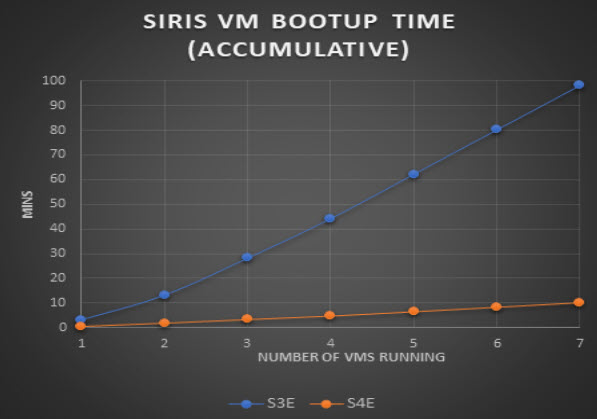SIRIS 3 vs SIRIS 4 Enterprise Comparison
This article compares hardware and virtualization performance of SIRIS 3 and SIRIS 4 Enterprise devices.
Environment
- Datto SIRIS 3 Enterprise
- Datto SIRIS 4 Enterprise
Description
Hardware comparison
| SIRIS 3 Enterprise | SIRIS 4 Enterprise | Improvements in SIRIS 4 | |
|---|---|---|---|
| CPU | Intel Broadwell | Intel Cascade Lake | Greater CPU core count 40% higher CPU performance |
| Memory | 4x channel Up to 32 GB per DIMM Up to 512 GB DIMM | 6x channel Up to 64 GB per DIMM Up to 1 TB DIMM | More channels More memory bandwidth More capacity |
| ZFS SLOG | None | Intel Optane NVMe | 10x faster VM boot Improved VM IOPS |
| NIC | 2x 10 Gbe | 2x 10 Gbe + 2x 1 Gbe | 2x additional 1 Gbe NIC |
| Hard Drive | Up to 6 TB HDD | Up to 12 TB HDD | Larger capacity drive Saves rack space |
| Backplane | Active backplane | Passive backplane | Improved reliability |
| Chassis | 2U and 4U | 2U only | Denser system Saves rack space |
Virtualization boot time test
This test compares how fast you can recover in the event of a disaster.
Test setup
- 10 Agents (Windows 7 server pack, new install, all identical).
- SIRIS 3 Enterprise (S3E): S3E36, dual Intel 2650 v4, 9x 6TB HDD, 128GB memory
- SIRIS 4 Enterprise (S4E): S4E36, dual Intel 4216, 9x 6TB HDD, 128GB memory
- Virtual machines for the agents were spun up one by one, and boot time was measured.
Test results
- S4E bootup time is much faster: 4 VMs take 5 minutes, ~9x faster than S3E (44 minutes).
- S3E takes longer to boot, especially when more VMs are running.
- S4E curve is linear and maintains consistent bootup time, which means that it can handle more VMs at the same time.
| VM boot up time in minutes (cumulative) | ||
|---|---|---|
| Number of VMs | SIRIS 3 Enterprise | SIRIS 4 Enterprise |
| 1 | 3 | 0.7 |
| 2 | 13 | 2 |
| 3 | 28 | 3 |
| 4 | 44 | 5 |
| 5 | 62 | 6 |
| 6 | 80 | 8 |
| 7 | 98 | 10 |
| 8 | 116 | 12 |

Figure 1: SIRIS VM bootup time
IOPS virtualization performance test
This test measures input and output per second (IOPS) within a virtual machine running on the Datto device.
Test setup
- 1 Agent (Windows 2012 R2, new install, with diskspd installed).
- Siris 3 Enterprise (S3E): S3E36, dual Intel 2650 v4, 9x 6TB HDD, 128GB memory installed.
- Siris 4 Enterprise (S4E): S4E36, dual Intel 4216, 9x 6TB HDD, 128GB memory installed.
- Test tool: diskspd. Storage performance tool written by Microsoft. Refer to https://github.com/microsoft/diskspd (external link) for details.
- Engineers ran diskspd in a Windows VM and measured the performance.
Test results
- Test 1-2 (100% write test): S4E gains 2000%-7000% improvement over S3E because SLOG offloads synchronous write away from the pool, and frees up resources for real application.
- Test 3-4 (100% read test): S4E shows 20-30% improvement over S3E. This result is reasonable as slog is a write buffer, doesnt help reading speed directly.
- Test 5 (70% read and 30% write): S4E is 71x times faster. Slog improves overall system performance when the system has a mixed workload.
| IOPS (diskspd) Test results | ||||
|---|---|---|---|---|
| Test | S3E IOPS | S4E IOPS | Percent improvement | |
| 1 | Random write (storage/incremental backup) | 206 | 14850 | 7097% |
| 2 | Sequential write (storage/backup/video surveillance) | 660 | 17525 | 2554% |
| 3 | Random read (Desktop/web server) | 22361 | 29597 | 32% |
| 4 | Sequential read (Video streaming/application server) | 26337 | 31803 | 21% |
| 5 | Random 70% read, 30% write (Database query/file server/email) | 243 | 17505 | 7104% |
Conclusions
- S4E is 9x faster at VM boot up because ZFS SLOG offloads a high-latency synchronous write from the pool drive and reduces data IO latency, thereby reducing the time to boot a VM.
- S4E has 25-70x better IOPS within the VM for write-related workload, thereby improving VM performance for a variety of real-time workloads.



